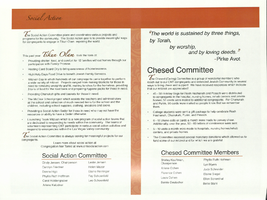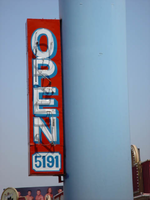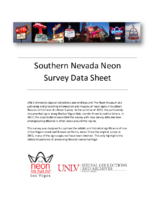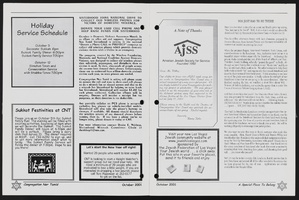Search the Special Collections and Archives Portal
Search Results

Annual report from Congregation Ner Tamid, 2011-2012
Date
Archival Collection
Description
Annual report from Congregation Ner Tamid, 2011-2012
Text

Photographs of Tourist Bureau signs, Las Vegas (Nev.), 2002.
Date
Archival Collection
Description
Site address: 5191 S Las Vegas Blvd
Sign owner: John Morris
Sign details: The Las Vegas Tourist Bureau is the first establishment on the strip after the McCarran Gates. It located in the south end of the property that is also occupied by the Klondike Motel Casino.
Sign condition: Structure 4 Surface 3 Lighting 3 Notes: Some of the lighting no longer works, and the surface seems to be deteriorating in spots. The structural integrity is good.
Sign form: pylon, fascia
Sign-specific description: The Las Vegas Tourist Bureau is the first establishment on the strip after the McCarran Gates. It located in the south end of the property that is also occupied by the Klondike Motel Casino. Upon the small low-rise structure, white, internally lit message centers wrap the flat roofline of the north and west sides of the building. The cabinet's steel housing is painted yellow to match the borders of the doors below. The cabinets form a giant entablature with giant black vinyl lettering. The north face reads "Show Tickets" in all capitals, and the west face reads "Grand Canyon" in smaller all caps lettering on the left hand side. Three words in the large all caps text reads "Tours," "Rooms," and weddings. Above the internally lit cabinets, the roof rises up several more feet, and is finished in red steel siding, with vertical panels made to look like wood. It is the same as the treatment seen on the Klondike. On the surface of this upper extension and above the cabinets, yellow raceways form a series of arches all along the fascia. They are lined with yellow incandescent bulbs. Standing right next to the entrances on the west face is the giant, double pole, pylon sign. The giant blue poles telescope up three levels, before a horizontal, rectangular, internally lit, yellow cabinet, lined with incandescent bulbs on the widths edge. The plastic face is white with red text. "Las Vegas" is written on the left-hand side at an angle in two lines, and "Tourist Bureau," written horizontally in two lines, in all capital text. A steel grated platform sits just above the cabinet on two extensions of the poles. The platform runs well beyond the edges of the backlit cabinet. On top of the grate a black LED message center runs the length of the platform. Next to the driveway into the small parking lot, a small internally lit sign stands street side. The small sign is two yellow steel cabinets, with white plastic faces, and incandescent bulbs running along the width's edge. They are treated to match the message cabinet on top of the main pylon sign. On top of a thin blue, steel post, a smaller cabinet supports another slightly larger one. The top cabinet reads "Entrance" in faded, red, all capital text. Just below the text on the face of the cabinet, a faded red arrow points east toward the parking lot. Neon tubing is crafted to create a reproduction of the shape, hovering over the surface. The bottom cabinet reads "Parking" in the same text, and condition. The three signs together form a cohesive, matching set of signage appropriate for the property. The sign is actually cohesive with the "Welcome to Fabulous Las Vegas" sign on the median just west of the actual structure.
Sign - type of display: neon, incandescent, backlit
Sign - media: steel, plastic
Sign animation: Chasing
Notes: The incandescent bulbs chase each other around the perimeter of the sign.
Sign environment: Just to the west on the median is the famous "Welcome to Las Vegas" sign, and the Klondike to the north. An expanse of field reaches south, past an attached structure on the south side of the building. That field is the airfield. The structure is highly visible from the north, but a bit less from the south due to heavy foliage placed directly south of the giant pylon. The Giant pylon is highly visible, but has high competition in it's midst. The Klondike when illuminated is very bright, and the Welcome to Las Vegas sign's popularity attracts a great amount of attention. The Las Vegas Tourist Bureau is sort of an afterthought.
Sign - thematic influences: The theme associated around these signs is not so evident. Yes they are the typical elements such as the internally lit cabinet and the border of incandescent bulbs. It is a roadside pole sign design, but it is a bit unique to it's area for it is extremely tall in its surroundings, and it is a double pole supporting internally lit cabinet. The thematic influence is also evident in relation to it's surroundings. It's coloring, and basic principle of design is based on the neighboring welcome to Las Vegas sign. The are both double poled, internally lit, and have incandescent bulbs which chase each other around the outside edge. The coloring of the Tourist Bureau sign parts corresponds with the same parts as the Welcome to Las Vegas sign as well.
Surveyor: Joshua Cannaday
Survey - date completed: 2002
Sign keywords: Pylon; Fascia; Neon; Incandescent; Backlit; Steel; Plastic; Chasing
Text

Crystal Palace Neon Survey document, September 6, 2017
Date
Archival Collection
Description
Site address: 4680 Boulder Hwy
Sign owner: Tim Poole
Sign details: The building was constructed in 1977 for this Skating Center. This skating center opened during the prime skating rink roller age of the 70's/80's. The Crystal Palace does have a second location in North Las Vegas on Rancho built in 1981 which is ran by Larry & Judy Sandord though still under Tim Poole's company. Crystal Palace holds birthday parties, themed nights and open skate for all ages.
Sign condition: 4- has had some weathering over the ages.
Sign form: Pylon and building signs
Sign-specific description: On Boulder Hwy they have a roadside sign that has a yellow steel base with a yellow curved sign box that is lined with yellow incandescent light bulbs. Inside this box is a back lit plastic sign that states "Crystal Palace" in a retro 1970's/80's double lined font. Within the two words there is a red circle that showcases a navy blue pair of roller skates and then states "USA" in white letters within the red circle with two white stars on either side of it. On both sides of the building there are thin red steel words "Crystal Palace Skating Center" that is down lit by LED lights.
Sign - type of display: Incandescent, LED and backlit plastic sign
Sign - media: Steel and plastic
Sign - non-neon treatments: Signs on building up lit by LED lights and the roadside sign is backlit plastic
Sign animation: Flasher for incandescent light bulbs
Sign environment: On Boulder Hwy towards the East side of Las Vegas. There is an RV lot across the street as well as other shopping centers.
Sign - date of installation: Has been up sine at least 2007
Sign - thematic influences: The roller skate image on the sign shows symbolism for what kind of company it is, as well as the font makes you think of the classic 70's/80's roller rink style.
Sign - artistic significance: The double lined font is very 1970/80s roller rink/ video game style (similar to SEGAs logo).
Survey - research locations: Assessor's page, Crystal Palace website http://www.skatevegas.com/ , google maps satellite and road view
Surveyor: Emily Fellmer
Survey - date completed: 2017-09-06
Sign keywords: Incandescent; Backlit; Plastic; Steel; Flashing; Building-front design; Pole sign
Text
Shelley Berkley oral history interview
Identifier
Abstract
Oral history interview with Shelley Berkley conducted by Barbara Tabach on February 13, 2015 for the Southern Nevada Jewish Heritage Project. In this interview, Berkley shares her family history, from her great-grandparents’ immigration to the United States to her immediate family’s migration from New York to Las Vegas, Nevada. She reflects upon her childhood experience in Las Vegas, including her varied leadership positions with Jewish organizations as well as at school, from junior high school through college. Berkley also talks about her involvement as an adult within the Jewish community and more broadly as a public servant, in all levels of government.
Archival Collection
Reika Sun oral history interview
Identifier
Abstract
Oral history interview with Reika Sun conducted by Kristel Peralta on June 21, 2021 for Reflections: The Las Vegas Asian American and Pacific Islander Oral History Project.
Reika Sun discusses her childhood in Shanghai, China during the "one-child policy" and her upbringing by nannies while her parents worked. She shares how her family immmigrated to Las Vegas in 2009 to reunite with Reika's aunt and how Reika moved to Kansas to attend an English as a Second Language (ESL) program at Kansas State University. Reika also talks about her restaurant employment history after returning to Las Vegas, her membership in the Culinary Workers Union, and Chinese traditions and superstitions she grew up learning.
Archival Collection
Amy Ayoub Papers
Identifier
Abstract
The Amy Ayoub Papers (1906-2022) document the life and career of Amy Ayoub, a long-time resident of Las Vegas, Nevada. The collection consists of correspondence, photographs, newspaper clippings, research, and other material that document the numerous facets of Ayoub's life. The collection covers many areas: Ayoub's early childhood; her family, including father Bobby Ayoub and stepfather Raymond Sutton; her financial consulting career and political work; her experience working as a prostitute in Nevada and subsequent documentary about being sex trafficked and working in brothels; time spent as the first female Nevada Athletic Commissioner; and more. Digital files include audio and video files of Mike Tyson's 2002 licensure hearing, and video of Ayoub's testimony before the Nevada State Assembly Judiciary Committee for Assembly Bill 67 in 2013. There are also digitized photographs that Ayoub used for the documentary The Zen Speaker: Breaking the Silence.
Archival Collection
Alice Key Papers
Identifier
Abstract
The Alice Key Papers (1936-2004) consist of documents detailing Alice Key’s life and work in the African American community, historic preservation, and labor relations in Las Vegas, Nevada. Included in the collection are awards and certificates documenting Key’s achievements, invitations and programs to events, political and civic correspondence, and magazine and newspaper articles both about Key and written by her. The collection also contains photographs.
Archival Collection



